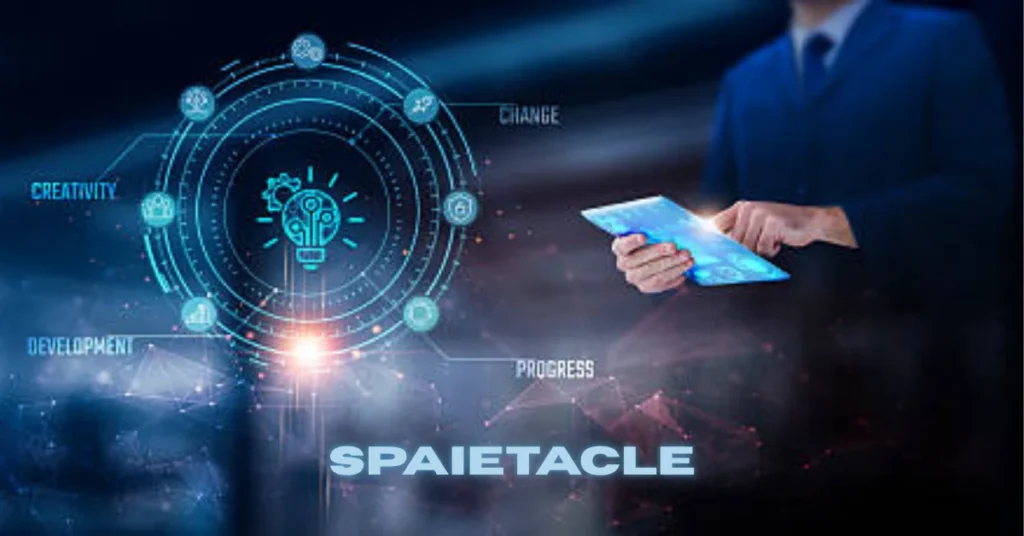In a world saturated by screens, notifications, and fleeting attention, Spaietacle emerges as a bold new paradigm. Not just a buzzword—it’s a creative fusion of space and spectacle, redefining how we experience entertainment, learning, work, and social interaction.
What Is Spaietacle?
At its heart, Spaietacle combines immersive environments with dramatic, sensory-rich displays. Think beyond passive viewing: here, users actively inhabit a world. It merges spatial design—VR, AR, MR—with storytelling, interactive visuals, and spatial audio. It promises experiences that respond directly to your presence and choices.
For instance, virtual galleries may adapt lighting and music depending on where you’re standing. Educational simulations could morph based on how you interact. It’s the next step in evolving digital interfaces into living, reactive worlds ghs.fr+6Peace Quarters+6Design Viva+6.
How It Transforms Digital Interaction
1. Spatial Storytelling
Spaietacle turns storytelling into a three-dimensional canvas. Viewers don’t just sip narrative—they walk through it. VR concerts might let you choose your vantage point or even remix audio elements.
2. Sensory Engagement
These environments engage multiple senses: depth-aware audio, dynamic lighting, and even haptic feedback. The effect? Memory-forming experiences—far beyond flat videos or articles.
3. Active Participation
The user becomes a collaborator. Touch, gaze, gesture—subtle interactions shape the unfolding environment. It’s a shift from watching to co-creating.
Core Technologies Driving Spaietacle
To deliver on its promise, Spaietacle leans on several emerging tech:
-
XR (Extended Reality) Platforms: Combining VR, AR, and MR to build blended worlds .
-
Real‑Time 3D Rendering Engines: Low-latency visuals that change with your actions Peace Quarters.
-
Sensor Inputs: Eye tracking, gesture sensors, spatial audio pickups—everything tuned to your presence Peace Quarters.
-
Artificial Intelligence: AI monitors your interaction patterns to adapt narrative pacing and even shift emotional tone Design Viva+9Peace Quarters+9Casuals mite+9.
These elements combine to produce cohesive, reactive worlds that feel alive and personal.
Real‑World Applications
Entertainment & Arts
Traditional performance art is evolving: immersive theaters now let audiences influence scenes by moving through sets or altering projections. Virtual concerts deepen fan connection with real-time solo remixes and spatial staging .
Interactive museums are popping up, overlaying historical exhibits with dynamic storytelling, animation, or even avatar guides repeating your speech .
Education & Training
Imagine walking through a molecular structure or practicing public speaking before a virtual audience. Spaietacle places learners inside their lessons, making abstract concepts tangible and retention stronger Xiaopan+5Peace Quarters+5Casuals mite+5.
Retail & Commerce
Brands are building AR showrooms where you can virtually try on clothes, inspect products, or experience a store in your living room—no physical trip needed .
Corporate Collaboration
The future of remote work may include holographic meetings in shared virtual spaces—complete with interactive whiteboards that respond to gestures and presence .
Compelling Benefits
-
Deeper Engagement: Participants don’t just watch—they feel invested in the outcome.
-
Personalization: AI-driven environments adapt to your pace, style, even mood.
-
Creative Fusion: Artists, developers, designers, audio engineers—and even architects—collaborate in new ways, weaving multiple creative disciplines .
-
Economic Growth: The immersive experience market is booming, with virtual tourism, branded XR, and entertainment tourism becoming trillion-dollar possibilities Peace Quarters.
Challenges Ahead
Spaietacle has tremendous potential, but also obstacles:
-
Technical Barriers
High-quality immersive experiences require advanced hardware (AR glasses, VR headsets), reliable 5G, and specialized software development ghs.fr+6Peace Quarters+6Casuals mite+6. -
Cost of Production
Building rich, interactive worlds demands investment—something small teams and underfunded projects may struggle with. -
Accessibility Issues
Not everyone owns the necessary gear or has the physical ability to experience XR environments. Designers must plan for inclusivity. -
Ethical Considerations
Immersion can border on emotional manipulation—privacy, consent, and mental health need careful guardrails.
The Cultural Resonance of Spaietacle
“Spectacle,” after all, originally meant an eyecatching display—something crafted to draw attention Wikipedia+5Peace Quarters+5Casuals mite+5oed.com+4Merriam-Webster+4Reddit+4. Spaietacle renews that tradition—but with far richer, more personalized layers.
Its power lies in combining sensory immersion with narrative purpose. It can entertain, educate, provoke empathy, and connect people across physical gaps. Like flamenco meets AI, or Renaissance theater fused with spatial computing, it taps into the timeless human draw toward story—amplified by modern tech Design Viva.
Getting Ready for the Spaietacle Era
Here’s how individuals and organizations can prepare:
-
Learn the Tools: Get hands-on with Unity, Unreal, ARKit, or ARCore.
-
Think Spatially: Plan narratives that unfold in three dimensions, not just along timelines.
-
Collaborate Across Disciplines: Combine visual arts with sound design, software engineering, spatial architecture.
-
Build Ethically: Prioritize user agency, accessibility, emotional safety, and data privacy.
Conclusion: Beyond Screens, Into Presence
Spaietacle marks a pivotal shift—from flat screens to “presence screens” that envelop and react. It invites us into storytelling environments so vivid they feel real. It bridges physical and digital spaces, human and machine interaction, art and data, emotion and code.
As the necessary technology matures and costs decline, expect Spaietacle to reshape how we gather, learn, shop, heal, and connect. Soon, sitting in a theater seat or scrolling through Instagram may feel quaint compared to living a story someone built just for you.


